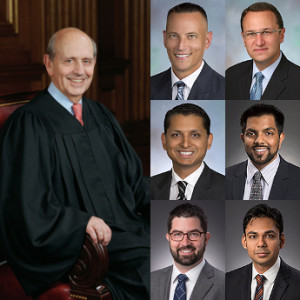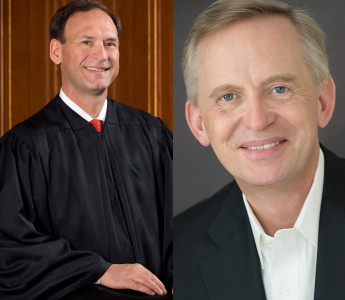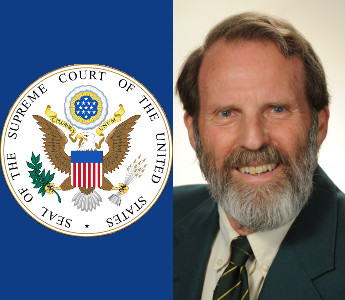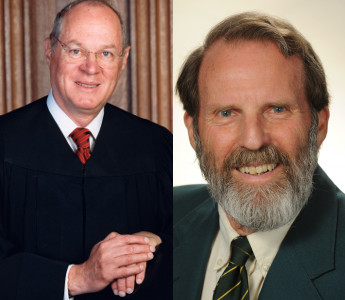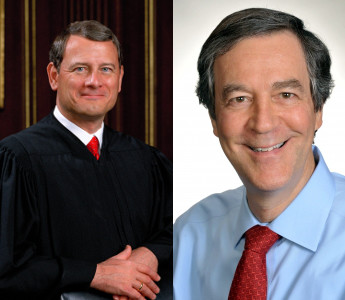Cuozzo Speed Technologies, LLC v. Lee, 579 U.S. ___ (2016) (Breyer, J.).
Response by Joseph Palys, Igor Timofeyev, Naveen Modi, Quadeer Ahmed, John Holley, & Chetan Bansal
Geo. Wash. L. Rev. On the Docket (Oct. Term 2015)
Slip Opinion | Reuters | SCOTUSblog
Business as Usual and Uncertainty for Post-Grant Proceedings
The Leahy-Smith America Invents Act (“AIA”)1 was enacted in 2012 to provide low-cost alternatives to ligation for challenging the validity of patents issued by the U.S. Patent and Trademark Office (“USPTO”). To that end, the AIA created post-grant proceedings, such as inter partes review (“IPR”), resulting in thousands of validity challenges before the USPTO’s Patent Trial and Appeal Board (“PTAB” or “Board”). Issues involving these proceedings have been making their way to the Federal Circuit and shaping the way patent validity issues are litigated before the PTAB. Now, for the first time, the Supreme Court weighed in on these highly publicized proceedings. Specifically, in Cuozzo Speed Technologies, LLC v. Lee,2 the Court addressed two key issues arising from the first IPR filed with the PTAB: the appropriate claim construction standard, and the judicial reviewability of certain PTAB decisions. The Court held that the PTAB may apply a different claim construction standard from that used by Article III courts, and that the PTAB’s decision to institute IPR is not reviewable except in special circumstances. Depending on where you sit, this highly-anticipated decision can be viewed as business as usual or as leaving the door open for further challenges.
The Broadest Reasonable Construction Standard Continues to Live
The PTAB is no stranger to attacks on its application of the broadest reasonable construction standard in post-grant proceedings.3 Here, likewise, Cuozzo challenged the USPTO’s rule requiring the PTAB to give a patent claim “its broadest reasonable construction” during IPR.4 The Court rejected Cuozzo’s argument that the USPTO should have required the PTAB to use the Phillips standard, which is meant to preserve a patent’s validity in federal court, during IPR. Characterizing post-grant proceedings as “hybrid,” the Court explained that IPR proceedings are “less like a judicial proceeding and more like a specialized agency proceeding.”5
The Court acknowledged that the AIA does not set forth a particular claim construction standard, but noted that 35 U.S.C. § 316(a)(4) “grants the Patent Office authority to issue ‘regulations . . . establishing and governing inter partes review’” and upheld the USPTO regulation at issue as “a reasonable exercise” of this “rulemaking authority.”6 The Court observed that, under the long-standing principles of Chevron U.S.A. Inc. v. Natural Resources Defense Council, Inc.,7 where there is “an express delegation [by Congress] of rulemaking authority” with respect to a statutory gap or ambiguity, the Court interprets the statute “as granting the agency leeway to enact rules that are reasonable in light of the text, nature, and purpose of the statute.”8
After examining the AIA, the Court concluded that “neither the statutory language, its purpose, or its history suggest that Congress considered what standard the agency should apply when reviewing a patent claim in inter partes review.”9 The Court then deferred to the USPTO’s choice of claim construction standard. In its reasoning, the Court stated that the USPTO has applied the broadest reasonable construction “standard for more than 100 years” and application of this standard “helps prevent a patent from tying up too much knowledge.”10 Finally, the Court was unpersuaded by the argument that applying the broadest reasonable construction standard is “unfair” to patent holders because of the limited opportunity to amend claims in an IPR and relatively low success rate for motions to amend in an IPR.11 According to the Court, this low success rate “may reflect the fact that no amendment could save the inventions at issue, i.e., that the patent should have never issued at all.”12
The Non-Reviewability of the PTAB Institution Decisions: Never Say Never?
Cuozzo also challenged the PTAB’s institution decision as running afoul of the “particularity” requirement of 35 U.S.C. § 312(a)(3) because the PTAB instituted an IPR on grounds not explicitly stated in the IPR petition.13 The Court rejected this challenge, albeit over a two-Justice dissent. The majority held that the plain language of 35 U.S.C. § 314(d), which states that a decision “to institute an inter partes review under this section shall be final and nonappealable,” bars judicial review of the PTAB’s institution decision, at least where the challenge to the institution decision “consist[s] of questions that are closely tied to the application and interpretation of statutes related to the Patent Office’s decision to initiate inter partes review.”14 The Court concluded that in this case, the traditional presumption in favor of judicial review has been overcome by “clear and convincing” indication that “Congress intended to bar review.”15
The Court stressed, however, that it was not deciding whether judicial review of the Board’s institution decisions is categorically foreclosed in all cases. Focusing on the phrase “under this section” in § 314(d), the Court emphasized that § 314(d) does not necessarily bar all judicial review of institution decisions, and that judicial review may still be available where the institution decision implicates “constitutional questions,” the agency action is “in excess of statutory jurisdiction,” or the agency action is “arbitrary [and] capricious.”16 The Court left open how such review could be procedurally pursued, such as through mandamus or on final appeal. In dissent, Justice Alito (joined by Justice Sotamayor) was concerned that without any judicial review, patent owners would be left without any remedy even if the PTAB failed to enforce the prohibitions against instituting an IPR (e.g., time limit or permissible grounds).17 The majority found that such “shenanigans” may be reviewable in the context of a party’s right to appeal a PTAB’s final decision under section 319 and under the Administrative Procedure Act.18
After Cuozzo: Life as We Know It, or New Departures?
So what now? Well, for one, it may be safe to assume that the Court’s decision settles, for now, at least absent any congressional action or change in the USPTO rules, the question of what claim construction standard will be applied by the PTAB in IPR proceedings and other proceedings such as post-grant review. In the aftermath of the Court’s decision, the attention will likely be further focused on how the PTAB and the Federal Circuit define and apply the broadest reasonable construction standard in IPR proceedings, which is nothing new to IPR practitioners.
There may also be a debate over whether a legislative modification of the broadest reasonable construction standard is needed in order to reconcile the potentially inconsistent validity determinations by an Article III court and the USPTO. While the high court accepted this inconsistency as “inherent to Congress’ regulatory design,”19 one can debate how such inconsistent constructions help achieve the AIA’s goal of providing low-cost alternatives to litigation. Of course, like any proposed legislation, any amendment to the AIA would face considerable hurdles.
Another development worth watching is the certiorari decision currently pending before the Court in MCM Portfolio v. HP.20 MCM asks the Court to decide whether an IPR violates Article III and the Seventh Amendment’s right to a jury trial. If it decides to grant certiorari, the Court will have to decide whether a U.S. patent is a “public right” or a “private right.” Hinting at this possible decision, Justice Alito (joined by Justice Sotomayor) expressly refers to a patent as a “property right,” in Cuozzo.21 At the same time, the majority’s comfort with the IPR proceedings as being akin to “a specialized agency proceeding,”22 cautions against the expectation that the Court will grant review.
The relatively limited nature of the Court’s ruling on reviewability also leaves open questions. Given that post-grant proceedings involve many factual and procedural issues specific to a particular case, the waiting game begins to see what types of institution decisions the Federal Circuit will find introduce a due process violation (or another constitutional claim), or are outside the scope of the PTAB’s statutory authority, or are arbitrary or capricious. Moreover, the Court left open the question of how a party may challenge an institution decision for such “shenanigans.” We can only wait and see whether the Federal Circuit will permit relief to be sought through mandamus (and, if so, when) or require a party to wait until it can appeal an adverse final written decision. If the latter, does that preclude a petitioner from seeking relief when the PTAB issues a decision not to institute review? For example, Cuozzo may introduce more questions as to whether the Federal Circuit’s decision in St. Jude Medical, Cardiology Division, Inc. v. Volcano Corporation23 categorically precludes a petitioner from appealing a non-institution decision in the face of constitutional issues raised by such a decision.
As with many issues involving post-grant proceedings, only time will tell.
Joe Palys is a partner in the Intellectual Property practice at Paul Hastings and is based in the firm’s Washington, D.C. office. He focuses his patent practice on litigation, post-grant proceedings, portfolio monetization and management, and client counseling. His technical experience is primarily in the areas of software, business methods, financial services, computer, network, and electro-mechanical technologies. Mr. Palys leans on his more than twenty years of patent experience to counsel small to very large clients regarding post-grant review proceedings implemented under the America Invents Act (AIA), and to provide infringement, validity, and product clearance opinions. He also has extensive experience in assessing, developing, implementing, and managing patent portfolios.
Igor Timofeyev is a partner in the Litigation practice of Paul Hastings and is based in the firm’s Washington, D.C., office. Mr. Timofeyev’s practice focuses on appellate litigation, as well as international arbitration and dispute resolution. He has represented corporations and business associations in appellate, trial, and regulatory proceedings involving constitutional, foreign affairs, securities, healthcare, patent, and antitrust issues. In the field of international litigation, Mr. Timofeyev has represented multinational corporations and foreign governments in World Trade Organization disputes, investor-state arbitration, ad hoc international commercial arbitration, and domestic U.S. litigation. In addition, he has advised clients on issues concerning investment treaties and free trade agreements.
Prior to entering private practice, Mr. Timofeyev served as a law clerk to Justice Anthony M. Kennedy of the U.S. Supreme Court.
Naveen Modi is a Global Vice Chair of the Intellectual Property group at Paul Hastings, overseeing the firm’s Global Intellectual Property group consisting of more than 100 attorneys. He also serves as the head of the firm’s Patent Office practice.
Mr. Modi’s practice includes all aspects of patent-related work, including litigation (U.S. district court and U.S. International Trade Commission), post-grant proceedings, interferences, client counseling, appeals, and opinions. Having been involved in well over 200 post-grant proceedings, including inter partes review, post-grant review, covered business method review, and ex parte and inter partes reexamination proceedings, Mr. Modi is one of the foremost experts in challenging and defending patents before the United States Patent and Trademark Office under the America Invents Act.
Quadeer A. Ahmed is an associate in the Litigation practice of Paul Hastings and is based in the firm’s Washington, D.C. office. Mr. Ahmed’s practice focuses on intellectual property matters, including patent litigation and post-grant proceedings (inter partes review, post grant review, and ex parte and inter partes reexamination proceedings).
John S. Holley is an associate in the Litigation practice of Paul Hastings and is based in the firm’s Washington, D.C. office. Mr. Holley practices all aspects of patent-related work, including litigation before U.S. district courts, post-grant proceedings, and client counseling.
Chetan Bansal is an associate in the Litigation practice of Paul Hastings and is based in the firm’s Washington, D.C. office. Mr. Bansal’s practice focuses on intellectual property matters, including patent office proceedings and litigation. Mr. Bansal has represented petitioners and patent owners in dozens of patent office post-grant proceedings, including inter partes review, and inter partes reexamination proceedings.
- 35 U.S.C. §100 et seq. (2012).
- Cuozzo Speed Techs., LLC v. Lee, No. 15-446 (U.S. June 20, 2016).
- See e.g., Versata Dev. Grp., Inc. v. SAP Am., Inc., 793 F.3d 1306, 1327–28 (Fed. Cir. 2015).
- Cuozzo, slip op. at 12.
- Id. at 12–16.
- Id. at 12–13, 17.
- Chevron U.S.A., Inc. v. Nat. Res. Def. Council, 467 U.S. 837 (1984).
- Cuozzo, slip op. at 13, 17 (citations omitted).
- Id. at 16.
- Id. at 17.
- Id. at 18–19.
- Id. at 19.
- Id. at 5–6.
- Id. at 7–8, 11.
- Id. at 9–10 (internal quotation marks and citation omitted).
- Id. at 11–12.
- Id. at 11–12 (Alito, J., concurring in part and dissenting in part).
- 5 U.S.C. § 706 (2012); Cuozzo, slip op. at 11–12 (majority opinion).
- Cuozzo, slip op. at 19.
- MCM Portfolio LLC v. Hewlett-Packard Co., 812 F.3d 1284 (Fed. Cir. 2015), petition for cert. filed, 84 U.S.L.W. 3617 (U.S. Apr. 29, 2016) (No.15-1330).
- Cuozzo, slip op. at 9 n.6 (Alito, J., concurring in part and dissenting in part).
- Id. at 15 (majority opinion).
- St. Jude Med., Cardiology Div., Inc. v. Volcano Corp., 749 F.3d 1373, 1375 (Fed. Cir. 2014).
Recommended Citation:
Joseph Palys et al., Response, Cuozzo Speed Technologies, LLC v. Lee: Business as Usual and Uncertainty for Post Grant Proceedings, Geo. Wash. L. Rev. On the Docket (June 27, 2016), http://www.gwlr.org/cuozzo-speed-technologies-llc-v-lee-business-as-usual-and-uncertainty-for-post-grant-proceedings/.

